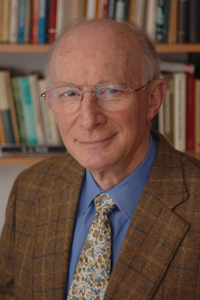Rice serving as Dean of Toyota Technological Institute, a computer science graduate program
By Steve KoppesNews Office
 Stuart Rice | |
While serving as Dean of the Physical Sciences Division from 1981 to 1995, Stuart Rice looked for opportunities to bring first-rate research organizations to campus. The idea was to infuse the campus with new intellectual life without necessarily increasing the size of the faculty.
Now Rice finds himself at the helm of just such an organization. In October, he began a three-year term as Dean of the Toyota Technological Institute at Chicago.
TTI at Chicago opened in 2003 in the University Press Building to provide graduate education in computer science.
“I always felt it would be to our advantage to attract these organizations to campus, to make available joint appointments and so on just to enlarge the intellectual ambience of the surroundings,” Rice said. “In that sense, although I didn’t envisage anything like TTI, it certainly fits that mold.”
The institution was founded by Japan’s Toyota Technological Institute, a small private engineering school supported by an endowment from the Toyota Motor Corporation. TTI president Mitsuru Nagasawa worked as a postdoctoral fellow in Rice’s laboratory from 1959 to 1961. When Nagasawa expressed interest in exploring the Chicago campus as a potential location for a TTI computer science graduate school, Rice put him in touch with colleagues in the University’s Computer Science Department.
Although TTI at Chicago operates independently, it has forged a close affiliation with the Computer Science Department. Graduate students at TTI at Chicago are eligible to take classes offered by the University and vice versa. Classes also are jointly offered by TTI at Chicago and the University’s Computer Science Department.
An early collaboration between the two took place in 2005, when they co-sponsored a Machine Learning Summer School and two weeklong workshops in the related field of learning theory. Machine learning is a branch of computer science that lends itself to applications such as detecting credit-card fraud and processing genetic data.
Although the arrangement between TTI and the University is unusual, there are other examples around the country, Rice said. These include the Harvard-Smithsonian Center for Astrophysics, a merger of the Smithsonian Astrophysical Observatory with the Harvard College Observatory, and the Carnegie Institution’s Department of Plant Biology on the campus of Stanford University.
The John Crerar Library represents a similar example closer to home. Founded as a public research library with a private endowment in 1897, Crerar’s home from 1962 to 1984 had been on the campus of the Illinois Institute of Technology. In 1984, Crerar moved to the University, where its collection merged with the University’s science collection.
Currently, TTI at Chicago has 14 faculty members and six students. By the year 2010, the Institute expects to have 30 faculty members and 24 students. Rice brings considerable academic leadership experience to the Institute as it goes through the accreditation process with the North Central Association. He served as Director of the James Franck Institute from 1961 to 1967, and as Chairman of the Chemistry Department from 1971 to 1976. He also oversaw the founding of the Computer Science Department while he was Dean of the Physical Sciences Division in 1985.
“It’s an interesting arrangement,” Rice said of having TTI at Chicago on campus. “I hope that it is successful enough to stimulate more such arrangements.”
![[Chronicle]](/images/sidebar_header_oct06.gif)